MXene Heterostructures as Perspective Materials for Gas Sensing Applications
Abstract
:1. Introduction
2. Two-Dimensional Materials for Sensing Applications
- (i)
- Metal oxide-based structures are characterized by high sensitivity to gas molecules and good stability. Besides their cheap and easy production in diverse and various nanostructured morphologies can be achieved [5,35]. The principle for operating metal oxide sensors is based on the sensing surface layer’s conductivity changes depending on the presence of gas in the environment. In general, the sensing mechanism includes several stages: adsorption of oxygen species on the semiconductor’s surface; electron transfer between semiconductor and oxygen; adsorption of the detected gas; chemical reaction; transfer of electron to the semiconductor; products desorption. In this case, the nanostructure and morphology of sensing materials has a great influence on the sensor performance. For example, a porous structure leads to an increase in the surface-to-volume ratio, and a large specific area provides more active sites for the adsorption of gas molecules [5,8].
- (ii)
- Graphene-based materials are promising candidates for the detection of gaseous molecules due to their high electrical conductivity, extremely high specific surface area and high charge carrier mobility [8,36,37]. The sensing principle of the graphene and graphene-derived structures is based on the direct charge transfer mechanism due to the adsorption/desorption of gas molecules, which leads to a change in the local charge carrier concentration [38]. Depending on the gas nature (electron donor or acceptor), an increase or decrease in electrical conductivity occurs.
- (iii)
- Two-dimensional layered structures of transition metal dichalcogenides, including MoS2, MoSe2 and WS2, are also characterized by good semiconducting properties, high surface area and excellent surface sensitivity, resulting in their widespread application for gas detection [33,39,40]. The sensing mechanism of metal dichalcogenides is similar to graphene-based materials and based on charge transfer between the surface and adsorbed molecules [41].
3. MXENES—Novel Two-Dimensional Compounds
3.1. Synthesis Approaches for the MXenes Production
Alternative Non-Fluorine Safe Synthesis Routes
3.2. High-Performance MXene-Based Gas Sensors
3.2.1. MXenes’ Sensing Mechanism
3.2.2. Sensors Based on Pure MXenes
3.2.3. MXenes-Based Heterostructures as Sensitive Layers
3.2.4. Two-Dimensional MXene Layered Materials for Gas Sensor Application
4. Conclusions
Author Contributions
Funding
Institutional Review Board Statement
Informed Consent Statement
Acknowledgments
Conflicts of Interest
References
- Ramgir, N.; Datta, N.; Kaur, M.; Kailasaganapathi, S.; Debnath, A.K.; Aswal, D.K.; Gupta, S.K. Metal oxide nanowires for chemiresistive gas sensors: Issues, challenges and prospects. Colloid Surf. A 2013, 439, 101–116. [Google Scholar] [CrossRef]
- Joshi, N.; Hayasaka, T.; Liu, Y.M.; Liu, H.L.; Oliveira, O.N.; Lin, L.W. A review on chemiresistive room temperature gas sensors based on metal oxide nanostructures, graphene and 2D transition metal dichalcogenides. Microchim. Acta 2018, 185, 213. [Google Scholar] [CrossRef] [PubMed]
- Seiyama, T.; Kato, A.; Fujiishi, K.; Nagatani, M. A new detector for gaseous components using semiconductive thin films. Anal. Chem. 1962, 34, 1502–1503. [Google Scholar] [CrossRef]
- Ponzoni, A.; Baratto, C.; Cattabiani, N.; Falasconi, M.; Galstyan, V.; Nunez-Carmona, E.; Rigoni, F.; Sberveglieri, V.; Zambotti, G.; Zappa, D. Metal oxide gas sensors, a survey of selectivity issues addressed at the SENSOR Lab, Brescia (Italy). Sensors 2017, 17, 714. [Google Scholar] [CrossRef] [PubMed] [Green Version]
- Sun, Y.F.; Liu, S.B.; Meng, F.L.; Liu, J.Y.; Jin, Z.; Kong, L.T.; Liu, J.H. Metal oxide nanostructures and their gas sensing properties: A Review. Sensors 2012, 12, 2610–2631. [Google Scholar] [CrossRef] [PubMed] [Green Version]
- Kim, S.J.; Koh, H.J.; Ren, C.E.; Kwon, O.; Maleski, K.; Cho, S.Y.; Anasori, B.; Kim, C.K.; Choi, Y.K.; Kim, J.; et al. Metallic Ti3C2Tx MXene gas sensors with ultrahigh signal-to-noise ratio. ACS Nano 2018, 12, 986–993. [Google Scholar] [CrossRef] [Green Version]
- Lee, E.; Mohammadi, A.V.; Prorok, B.C.; Yoon, Y.S.; Beidaghi, M.; Kim, D.J. Room temperature gas sensing of two-dimensional titanium carbide (MXene). ACS Appl. Mater. Interfaces 2017, 9, 37184–37190. [Google Scholar] [CrossRef]
- Liu, X.H.; Ma, T.T.; Pinna, N.; Zhang, J. Two-dimensional nanostructured materials for gas sensing. Adv. Funct. Mater. 2017, 27, 1702168. [Google Scholar] [CrossRef]
- Coleman, J.N.; Lotya, M.; O’Neill, A.; Bergin, S.D.; King, P.J.; Khan, U.; Young, K.; Gaucher, A.; De, S.; Smith, R.J.; et al. Two-dimensional nanosheets produced by liquid exfoliation of layered materials. Science 2011, 331, 568–571. [Google Scholar] [CrossRef] [Green Version]
- Mei, Y.F.; Huang, G.S.; Solovev, A.A.; Urena, E.B.; Moench, I.; Ding, F.; Reindl, T.; Fu, R.K.Y.; Chu, P.K.; Schmidt, O.G. Versatile approach for integrative and functionalized tubes by strain engineering of nanomembranes on polymers. Adv. Mater. 2008, 20, 4085–4090. [Google Scholar] [CrossRef]
- Ji, Q.Q.; Zhang, Y.; Zhang, Y.F.; Liu, Z.F. Chemical vapour deposition of group-VIB metal dichalcogenide monolayers: Engineered substrates from amorphous to single crystalline. Chem. Soc. Rev. 2015, 44, 2587–2602. [Google Scholar] [CrossRef] [PubMed]
- Zhuang, X.D.; Mai, Y.Y.; Wu, D.Q.; Zhang, F.; Feng, X.L. Two-dimensional soft nanomaterials: A fascinating world of materials. Adv. Mater. 2015, 27, 403–427. [Google Scholar] [CrossRef] [PubMed]
- Zhang, J.; Liu, X.H.; Neri, G.; Pinna, N. Nanostructured materials for room-temperature gas sensors. Adv. Mater. 2016, 28, 795–831. [Google Scholar] [CrossRef] [PubMed]
- Franke, M.E.; Koplin, T.J.; Simon, U. Metal and metal oxide nanoparticles in chemiresistors: Does the nanoscale matter? Small 2006, 2, 36–50. [Google Scholar] [CrossRef] [PubMed]
- Majhi, S.M.; Rai, P.; Yu, Y.T. Facile approach to synthesize Au@ZnO core-shell nanoparticles and their application for highly sensitive and selective gas sensors. ACS Appl. Mater. Interfaces 2015, 7, 9462–9468. [Google Scholar] [CrossRef] [PubMed]
- Ueda, T.; Abe, H.; Kamada, K.; Bishop, S.R.; Tuller, H.L.; Hyodo, T.; Shimizu, Y. Enhanced sensing response of solid-electrolyte gas sensors to toluene: Role of composite Au/metal oxide sensing electrode. Sens. Actuators B Chem. 2017, 252, 268–276. [Google Scholar] [CrossRef] [Green Version]
- Kaushik, A.; Kumar, R.; Arya, S.K.; Nair, M.; Malhotra, B.D.; Bhansali, S. Organic-inorganic hybrid nanocomposite-based gas sensors for environmental monitoring. Chem. Rev. 2015, 115, 4571–4606. [Google Scholar] [CrossRef]
- Schutt, F.; Postica, V.; Adelung, R.; Lupan, O. Single and networked ZnO-CNT hybrid tetrapods for selective room-temperature high-performance ammonia sensors. ACS Appl. Mater. Interfaces 2017, 9, 23107–23118. [Google Scholar] [CrossRef]
- Chen, G.G.; Paronyan, T.M.; Pigos, E.M.; Harutyunyan, A.R. Enhanced gas sensing in pristine carbon nanotubes under continuous ultraviolet light illumination. Sci. Rep. 2012, 2, 343. [Google Scholar] [CrossRef]
- Chang, Y.; Tang, N.; Qu, H.M.; Liu, J.; Zhang, D.H.; Zhang, H.; Pang, W.; Duan, X.X. Detection of volatile organic compounds by self-assembled monolayer coated sensor array with concentration-independent fingerprints. Sci. Rep. 2016, 6, 23970. [Google Scholar] [CrossRef]
- Gogotsi, Y.; Anasori, B. The rise of MXenes. ACS Nano 2019, 13, 8491–8494. [Google Scholar] [CrossRef] [PubMed] [Green Version]
- Li, Q.; Li, Y.; Zeng, W. Preparation and application of 2D MXene-based gas sensors: A Review. Chemosensors 2021, 9, 225. [Google Scholar] [CrossRef]
- Lee, E.; Kim, D.J. Review—Recent exploration of two-dimensional MXenes for gas sensing: From a theoretical to an experimental view. J. Electrochem. Soc. 2019, 167, 037515. [Google Scholar] [CrossRef] [Green Version]
- Pei, Y.Y.; Zhang, X.L.; Hui, Z.Y.; Zhou, J.Y.; Huang, X.; Sun, G.Z.; Huang, W. Ti3C2Tx MXene for sensing applications: Recent progress, design principles, and future perspectives. ACS Nano 2021, 15, 3996–4017. [Google Scholar] [CrossRef]
- Ju, D.X.; Xu, H.Y.; Zhang, J.; Guo, J.; Cao, B.Q. Direct hydrothermal growth of ZnO nanosheets on electrode for ethanol sensing. Sens. Actuators B Chem. 2014, 201, 444–451. [Google Scholar] [CrossRef]
- Li, T.M.; Zeng, W.; Long, H.W.; Wang, Z.C. Nanosheet-assembled hierarchical SnO2 nanostructures for efficient gas-sensing applications. Sens. Actuators B Chem. 2016, 231, 120–128. [Google Scholar] [CrossRef]
- Li, Z.J.; Wang, N.N.; Lin, Z.J.; Wang, J.Q.; Liu, W.; Sun, K.; Fu, Y.Q.; Wang, Z.G. Room-temperature high-performance H2S sensor based on porous CuO nanosheets prepared by hydrothermal method. ACS Appl. Mater. Interfaces 2016, 8, 20962–20968. [Google Scholar] [CrossRef]
- Li, Q.; Du, Y.; Li, X.J.; Lu, G.Y.; Wang, W.Y.; Geng, Y.F.; Liang, Z.Q.; Tian, X.Q. Different Co3O4 mesostructures synthesised by templating with KIT-6 and SBA-15 via nanocasting route and their sensitivities toward ethanol. Sens. Actuators B Chem. 2016, 235, 39–45. [Google Scholar] [CrossRef]
- Milowska, K.Z.; Majewsk, J.A. Graphene-based sensors: Theoretical study. J. Phys. Chem. C 2014, 118, 17395–17401. [Google Scholar] [CrossRef] [Green Version]
- Nurazzi, N.M.; Abdullah, N.; Demon, S.Z.N.; Halim, N.A.; Azmi, A.F.M.; Knight, V.F.; Mohamad, I.S. The frontiers of functionalized graphene-based nanocomposites as chemical sensors. Nanotechnol. Rev. 2021, 10, 330–369. [Google Scholar] [CrossRef]
- Kumar, V.; Vikrant, K.; Kim, K.H. Use of graphene-based structures as platforms for the trace-level detection of gaseous formaldehyde and insights into their superior sensing potentials. Trends Anal. Chem. 2019, 121, 115694. [Google Scholar] [CrossRef]
- Lee, E.; Yoon, Y.S.; Kim, D.J. Two-dimensional transition metal dichalcogenides and metal oxide hybrids for gas sensing. ACS Sens. 2018, 3, 2045–2060. [Google Scholar] [CrossRef] [PubMed]
- Kumar, R.; Zheng, W.; Liu, X.H.; Zhang, J.; Kumar, M. MoS2-based nanomaterials for room-temperature gas sensors. Adv. Mater. Technol. 2020, 5, 1901062. [Google Scholar] [CrossRef]
- Kumar, R.; Goel, N.; Hojamberdiev, M.; Kumar, M. Transition metal dichalcogenides-based flexible gas sensors. Sens. Actuators A Phys. 2020, 303, 111875. [Google Scholar] [CrossRef]
- Wang, C.X.; Yin, L.W.; Zhang, L.Y.; Xiang, D.; Gao, R. Metal oxide gas sensors: Sensitivity and influencing factors. Sensors 2010, 10, 2088–2106. [Google Scholar] [CrossRef] [Green Version]
- Yang, T.; Zhao, X.; He, Y.; Zhu, H. Graphene-based sensors. In Graphene. Fabrication, Characterizations, Properties and Applications; Academic Press: Cambridge, MA, USA, 2018; pp. 157–174. [Google Scholar]
- Choi, J.H.; Lee, J.; Byeon, M.; Hong, T.E.; Park, H.; Lee, C.Y. Graphene-based gas sensors with high sensitivity and minimal sensor-to-sensor variation. ACS Appl. Nano Mater. 2020, 3, 2257–2265. [Google Scholar] [CrossRef]
- Gerasimov, G.Y. Graphene-based gas sensors. Adv. Environ. Anal. Appl. Nanomater. 2017, 2, 133–152. [Google Scholar]
- Jha, R.K.; D’Costa, J.V.; Sakhuja, N.; Bhat, N. MoSe2 nanoflakes based chemiresistive sensors for ppb-level hydrogen sulfide gas detection. Sens. Actuators B Chem. 2019, 297, 126687. [Google Scholar] [CrossRef] [Green Version]
- Jarvinen, T.; Lorite, G.S.; Perantie, J.; Toth, G.; Saarakkala, S.; Virtanen, V.K.; Kordas, K. WS2 and MoS2 thin film gas sensors with high response to NH3 in air at low temperature. Nanotechnology 2019, 30, 405501. [Google Scholar] [CrossRef] [Green Version]
- Cho, B.; Hahm, M.G.; Choi, M.; Yoon, J.; Kim, A.R.; Lee, Y.J.; Park, S.G.; Kwon, J.D.; Kim, C.S.; Song, M.; et al. Charge-transfer-based gas sensing using atomic-layer MoS2. Sci. Rep. 2015, 5, 8052. [Google Scholar] [CrossRef]
- Zhang, L.X.; Yin, Y.Y. Hierarchically mesoporous SnO2 nanosheets: Hydrothermal synthesis and highly ethanol-sensitive properties operated at low temperature. Sens. Actuators B Chem. 2013, 185, 594–601. [Google Scholar] [CrossRef]
- Jeong, H.Y.; Lee, D.S.; Choi, H.K.; Lee, D.H.; Kim, J.E.; Lee, J.Y.; Lee, W.J.; Kim, S.O.; Choi, S.Y. Flexible room-temperature NO2 gas sensors based on carbon nanotubes/reduced graphene hybrid films. Appl. Phys. Lett. 2010, 96, 213105. [Google Scholar] [CrossRef] [Green Version]
- Aleixandre, M.; Horrillo, M.C.; Benito, A.; Maser, W.K. Graphene sensors operating at room temperature for detection of low concentrations of NO2. In Proceedings of the 2018 Spanish Conference on Electron Devices (CDE), Salamanca, Spain, 14–16 November 2018. [Google Scholar]
- Li, S.H.; Meng, F.F.; Chu, Z.; Luo, T.; Peng, F.M.; Jin, Z. Mesoporous SnO2 nanowires: Synthesis and ethanol sensing properties. Adv. Cond. Matter Phys. 2017, 2017, 9720973. [Google Scholar] [CrossRef] [Green Version]
- Soomro, R.A.; Jawaid, S.; Zhu, Q.Z.; Abbas, Z.; Xu, B. A mini-review on MXenes as versatile substrate for advanced sensors. Chin. Chem. Lett. 2020, 31, 922–930. [Google Scholar] [CrossRef]
- Verma, C.; Thakur, K.K. Recent advances in MXene-based electrochemical sensors. Eur. J. Mol. Clin. Med. 2020, 7, 4429–4450. [Google Scholar]
- Hermawan, A.; Zhang, B.; Taufik, A.; Asakura, Y.; Hasegawa, T.; Zhu, J.; Shi, P.; Yin, S. CuO nanoparticles/Ti3C2Tx MXene hybrid nanocomposites for detection of Toluene gas. Appl. Nano Mater. 2020, 3, 4755–4766. [Google Scholar] [CrossRef]
- Lee, E.; Vahid-Mohammadi, A.; Yoon, Y.S.; Beidaghi, M.; Kim, D.J. Two-dimensional vanadium carbide MXene for gas sensors with ultrahigh sensitivity toward nonpolar gases. ACS Sens. 2019, 4, 1603–1611. [Google Scholar] [CrossRef]
- Deshmukh, K.; Kovarik, T.; Pasha, S.K.K. State of the art recent progress in two dimensional MXenes based gas sensors and biosensors: A comprehensive review. Coordin. Chem. Rev. 2020, 424, 213514. [Google Scholar] [CrossRef]
- Naguib, M.; Kurtoglu, M.; Presser, V.; Lu, J.; Niu, J.; Heon, M.; Hultman, L.; Gogotsi, Y.; Barsoum, M.W. Two-dimensional nanocrystals produced by exfoliation of Ti3AlC2. Adv. Mater. 2011, 23, 4248–4253. [Google Scholar] [CrossRef] [Green Version]
- Aghaei, S.M.; Aasi, A.; Panchapakesan, B. Experimental and theoretical advances in MXene-based gas sensors. ACS Omega 2021, 6, 2450–2461. [Google Scholar] [CrossRef]
- Lee, E.; Mohammadi, A.V.; Lee, D.; Yoon, J.; Lincoln, C.; Biefaghi, M.; Woo, S.; Yoon, Y.; Kim, D.-J. Exploration of new two-dimensional titanium carbides for room temperature gas sensors. In ECS Meeting Abstracts; IOP Publishing: Bristol, UK, 2017. [Google Scholar]
- Wang, H.; Wu, Y.; Yuan, X.; Zeng, G.; Zhou, J.; Wang, X.; Chew, J.W. Clay-inspired MXene-based electrochemical devices and photo-electrocatalyst: State-of-the-art progresses and challenges. Adv. Mater. 2018, 30, e1704561. [Google Scholar] [CrossRef] [PubMed]
- Chen, W.Y.; Jiang, X.F.; Lai, S.N.; Peroulis, D.; Stanciu, L. Nanohybrids of a MXene and transition metal dichalcogenide for selective detection of volatile organic compounds. Nat. Commun. 2020, 11, 1302. [Google Scholar] [CrossRef] [PubMed] [Green Version]
- Bae, S.; Kang, Y.G.; Khazaei, M.; Ohno, K.; Kim, Y.H.; Han, M.J.; Chang, K.J.; Raebiger, H. Electronic and magnetic properties of carbide MXenes-the role of electron correlations. Mater. Today Adv. 2021, 9, 100118. [Google Scholar] [CrossRef]
- Alhabeb, M.; Maleski, K.; Anasori, B.; Lelyukh, P.; Clark, L.; Sin, S.; Gogotsi, Y. Guidelines for synthesis and processing of two-dimensional Titanium Carbide (Ti3C2Tx MXene). Chem. Mater. 2017, 29, 7633–7644. [Google Scholar] [CrossRef]
- Chaudhari, N.K.; Jin, H.; Kim, B.; Baek, D.S.; Joo, S.H.; Lee, K. MXene: An emerging two-dimensional material for future energy conversion and storage applications. J. Mater. Chem. A 2017, 5, 24564–24579. [Google Scholar] [CrossRef]
- Naguib, M.; Mochalin, V.N.; Barsoum, M.W.; Gogotsi, Y. 25th anniversary article: MXenes: A new family of two-dimensional materials. Adv. Mater. 2014, 26, 992–1005. [Google Scholar] [CrossRef]
- Naguib, M.; Unocic, R.R.; Armstrong, B.L.; Nanda, J. Large-scale delamination of multi-layers transition metal carbides and carbonitrides “MXenes”. Dalton Trans. 2015, 44, 9353–9358. [Google Scholar] [CrossRef]
- Naguib, M.; Mashtalir, O.; Carle, J.; Presser, V.; Lu, J.; Hultman, L.; Gogotsi, Y.; Barsoum, M.W. Two-dimensional transition metal carbides. ACS Nano 2012, 6, 1322–1331. [Google Scholar] [CrossRef]
- Mashtalir, O.; Naguib, M.; Mochalin, V.N.; Dall’Agnese, Y.; Heon, M.; Barsoum, M.W.; Gogotsi, Y. Intercalation and delamination of layered carbides and carbonitrides. Nat. Commun. 2013, 4, 1716. [Google Scholar] [CrossRef]
- Halim, J.; Lukatskaya, M.R.; Cook, K.M.; Lu, J.; Smith, C.R.; Naslund, L.A.; May, S.J.; Hultman, L.; Gogotsi, Y.; Eklund, P.; et al. Transparent conductive two-dimensional titanium carbide epitaxial thin films. Chem. Mater. 2014, 26, 2374–2381. [Google Scholar] [CrossRef]
- Ghidiu, M.; Lukatskaya, M.R.; Zhao, M.Q.; Gogotsi, Y.; Barsoum, M.W. Conductive two-dimensional titanium carbide ’clay’ with high volumetric capacitance. Nature 2014, 516, 78–81. [Google Scholar] [CrossRef]
- Sang, X.H.; Xie, Y.; Lin, M.W.; Alhabeb, M.; Van Aken, K.L.; Gogotsi, Y.; Kent, P.R.C.; Xiao, K.; Unocic, R.R. Atomic defects in monolayer titanium carbide (Ti3C2Tx) MXene. ACS Nano 2016, 10, 9193–9200. [Google Scholar] [CrossRef] [PubMed]
- Ren, C.; Zhao, M.Q.; Makaryan, T.; Halim, J.; Boota, M.; Barsoum, M.; Gogotsi, Y. Porous 2D transition metal carbides (MXenes) for high-performance lithium-ion storage. In Abstracts of Papers of the American Chemical Society; Americal Chemical Society: Washington, DC, USA, 2016; Volume 252. [Google Scholar]
- Mathis, T.S.; Maleski, K.; Goad, A.; Sarycheva, A.; Anayee, M.; Foucher, A.C.; Hantanasirisakul, K.; Shuck, C.E.; Stach, E.A.; Gogotsi, Y. Modified MAX phase synthesis for environmentally stable and highly conductive Ti3C2 MXene. ACS Nano 2021, 15, 6420–6429. [Google Scholar] [CrossRef] [PubMed]
- Lipatov, A.; Alhabeb, M.; Lukatskaya, M.R.; Boson, A.; Gogotsi, Y.; Sinitskii, A. Effect of synthesis on quality, electronic properties and environmental stability of individual monolayer Ti3C2 MXene flakes. Adv. Electron. Mater. 2016, 2, 1600255. [Google Scholar] [CrossRef] [Green Version]
- Li, M.; Lu, J.; Luo, K.; Li, Y.; Chang, K.; Chen, K.; Zhou, J.; Rosen, J.; Hultman, L.; Eklund, P.; et al. Element replacement approach by reaction with Lewis acidic molten salts to synthesize nanolaminated MAX phases and MXenes. J. Am. Chem. Soc. 2019, 141, 4730–4737. [Google Scholar] [CrossRef] [Green Version]
- Li, Y.; Shao, H.; Lin, Z.; Lu, J.; Liu, L.; Duployer, B.; Persson, P.O.A.; Eklund, P.; Hultman, L.; Li, M.; et al. A general Lewis acidic etching route for preparing MXenes with enhanced electrochemical performance in non-aqueous electrolyte. Nat. Mater. 2020, 19, 894–899. [Google Scholar] [CrossRef] [Green Version]
- Li, T.; Yao, L.; Liu, Q.; Gu, J.; Luo, R.; Li, J.; Yan, X.; Wang, W.; Liu, P.; Chen, B.; et al. Fluorine-free synthesis of high-purity Ti3C2Tx (T=OH, O) via alkali treatment. Angew. Chem. Int. Ed. 2018, 57, 6115–6119. [Google Scholar] [CrossRef]
- Yang, S.; Zhang, P.; Wang, F.; Ricciardulli, A.G.; Lohe, M.R.; Blom, P.W.M.; Feng, X. Fluoride-free synthesis of two-dimensional titanium carbide (MXene) using a binary aqueous system. Angew. Chem. Int. Ed. 2018, 57, 15491–15495. [Google Scholar] [CrossRef]
- Jawaid, A.; Hassan, A.; Neher, G.; Nepal, D.; Pachter, R.; Kennedy, W.J.; Ramakrishnan, S.; Vaia, R.A. Halogen etch of Ti3AlC2 MAX phase for MXene fabrication. ACS Nano 2021, 15, 2771–2777. [Google Scholar] [CrossRef]
- Gogotsi, Y. Chemical vapour deposition. Transition metal carbides go 2D. Nat. Mater. 2015, 14, 1079–1080. [Google Scholar] [CrossRef]
- Jia, J.; Xiong, T.L.; Zhao, L.L.; Wang, F.L.; Liu, H.; Hu, R.Z.; Zhou, J.; Zhou, W.J.; Chen, S.W. Ultrathin N-doped Mo2C nanosheets with exposed active sites as efficient electrocatalyst for hydrogen evolution reactions. ACS Nano 2017, 11, 12509–12518. [Google Scholar] [CrossRef]
- Xiao, X.; Yu, H.M.; Jin, H.Y.; Wu, M.H.; Fang, Y.S.; Sun, J.Y.; Hu, Z.M.; Li, T.Q.; Wu, J.B.; Huang, L.; et al. Salt-templated synthesis of 2D Metallic MoN and other nitrides. ACS Nano 2017, 11, 2180–2186. [Google Scholar] [CrossRef] [PubMed]
- Xu, C.; Wang, L.B.; Liu, Z.B.; Chen, L.; Guo, J.K.; Kang, N.; Ma, X.L.; Cheng, H.M.; Ren, W.C. Large-area high-quality 2D ultrathin Mo2C superconducting crystals. Nat. Mater. 2015, 14, 1135–1141. [Google Scholar] [CrossRef] [PubMed]
- Barsan, N.; Weimar, U. Conduction model of metal oxide gas sensors. J. Electroceram. 2001, 7, 143–167. [Google Scholar] [CrossRef]
- Yu, X.F.; Li, Y.C.; Cheng, J.B.; Liu, Z.B.; Li, Q.Z.; Li, W.Z.; Yang, X.; Xiao, B. Monolayer Ti2CO2: A promising candidate for NH3 sensor or capturer with high sensitivity and selectivity. ACS Appl. Mater. Interfaces 2015, 7, 13707–13713. [Google Scholar] [CrossRef] [PubMed]
- Xiao, B.; Li, Y.C.; Yu, X.F.; Cheng, J.B. MXenes: Reusable materials for NH3 sensor or capturer by controlling the charge injection. Sens. Actuators B Chem. 2016, 235, 103–109. [Google Scholar] [CrossRef]
- Wu, M.; He, M.; Hu, Q.; Wu, Q.; Sun, G.; Xie, L.; Zhang, Z.; Zhu, Z.; Zhou, A. Ti3C2 Mxene-based sensors with high selectivity for NH3 detection at room temperature. ACS Sens. 2019, 4, 2763–2770. [Google Scholar] [CrossRef]
- Yang, Z.J.; Liu, A.; Wang, C.L.; Liu, F.M.; He, J.M.; Li, S.Q.; Wang, J.; You, R.; Yan, X.; Sun, P.; et al. Improvement of gas and humidity sensing properties of organ-like MXene by alkaline treatment. ACS Sens. 2019, 4, 1261–1269. [Google Scholar] [CrossRef]
- Zhao, W.-N.; Yun, N.; Dai, Z.-H.; Li, Y.-F. A high-performance trace level acetone sensor using an indispensable V4C3Tx MXene. RSC Adv. 2020, 10, 1261. [Google Scholar] [CrossRef] [Green Version]
- Yuan, W.J.; Yang, K.; Peng, H.F.; Li, F.; Yin, F.X. A flexible VOCs sensor based on a 3D Mxene framework with a high sensing performance. J. Mater. Chem. A 2018, 6, 18116–18124. [Google Scholar] [CrossRef]
- Guo, W.; Surya, S.G.; Babar, V.; Ming, F.; Sharma, S.; Alshareef, H.N.; Schwingenschlögl Salam, K.N. Selective toluene detection with Mo2CTx Mxene at room temperature. ACS Appl. Mater. Interfaces 2020, 12, 57218–57227. [Google Scholar] [CrossRef]
- He, T.T.; Liu, W.; Lv, T.; Ma, M.S.; Liu, Z.F.; Vasiliev, A.; Li, X.G. MXene/SnO2 heterojunction based chemical gas sensors. Sens. Actuators B Chem. 2021, 329, 129275. [Google Scholar] [CrossRef]
- Lee, S.H.; Eom, W.; Shin, H.; Ambade, R.B.; Bang, J.H.; Kim, H.W.; Han, T.H. Room-temperature, highly durable Ti3C2Tx MXene/graphene hybrid fibers for NH3 gas sensing. ACS Appl. Mater. Interfaces 2020, 12, 10434–10442. [Google Scholar] [CrossRef] [PubMed]
- Yang, Z.J.; Jiang, L.; Wang, J.; Liu, F.M.; He, J.M.; Liu, A.; Lv, S.Y.; You, R.; Yan, X.; Sun, P.; et al. Flexible resistive NO2 gas sensor of three-dimensional crumpled MXene Ti3C2Tx/ZnO spheres for room temperature application. Sens. Actuators B Chem. 2021, 326, 128828. [Google Scholar] [CrossRef]
- Tai, H.L.; Duan, Z.H.; He, Z.Z.; Li, X.; Xu, J.L.; Liu, B.H.; Jiang, Y.D. Enhanced ammonia response of Ti3C2Tx nanosheets supported by TiO2 nanoparticles at room temperature. Sens. Actuators B Chem. 2019, 298, 126874. [Google Scholar] [CrossRef]
- Li, N.; Jiang, Y.; Zhou, C.; Xiao, Y.; Meng, B.; Wang, Z.; Huang, D.; Xing, C.; Peng, Z. High-performance humidity sensor based on urchin-like composite of Ti3C2 MXene-derived TiO2 nanowires. ACS Appl. Mater. Interfaces 2019, 11, 38116–38125. [Google Scholar] [CrossRef] [PubMed]
- Doan, T.H.P.; Hong, W.G.; Noh, J.S. Palladium nanoparticle-decorated multi-layer Ti3C2Tx dual-functioning as a highly sensitive hydrogen gas sensor and hydrogen storage. RSC Adv. 2021, 11, 7492–7501. [Google Scholar] [CrossRef]
- Zhu, Z.Y.; Liu, C.C.; Jiang, F.X.; Liu, J.; Ma, X.M.; Liu, P.; Xu, J.K.; Wang, L.; Huang, R. Flexible and lightweight Ti3C2Tx MXene@Pd colloidal nanoclusters paper film as novel H2 sensor. J. Hazard. Mater. 2020, 399, 123054. [Google Scholar] [CrossRef]
- Yu, L.P.; Zhou, X.H.; Lu, L.; Xu, L.; Wang, F.J. MXene/Carbon nanotube hybrids: Synthesis, structures, properties, and applications. ChemSusChem 2021, 14, 5079. [Google Scholar] [CrossRef]
- Cai, Y.C.; Shen, J.; Ge, G.; Zhang, Y.Z.; Jin, W.Q.; Huang, W.; Shao, J.J.; Yang, J.; Dong, X.C. Stretchable Ti3C2Tx MXene/Carbon nanotube composite based strain sensor with ultrahigh sensitivity and tunable sensing range. ACS Nano 2018, 12, 56–62. [Google Scholar] [CrossRef]
- Liu, Z.; Wang, J.L.; Kushvaha, V.; Poyraz, S.; Tippur, H.V.; Park, S.; Kim, M.; Liu, Y.; Bar, J.; Chen, H.; et al. Poptube approach for ultrafast carbon nanotube growth. Chem. Commun. 2011, 47, 9912–9914. [Google Scholar] [CrossRef] [PubMed]
- Liu, Z.; Zhang, L.; Poyraz, S.; Smith, J.; Kushvaha, V.; Tippur, H.V.; Zhang, X.Y. An ultrafast microwave approach towards multicomponent and multi-dimensional nanomaterials. RSC Adv. 2014, 4, 9308–9313. [Google Scholar] [CrossRef]
- Bai, H.; Shi, G.Q. Gas sensors based on conducting polymers. Sensors 2007, 7, 267–307. [Google Scholar] [CrossRef] [Green Version]
- Lobotka, P.; Kunzo, P.; Kovacova, E.; Vavra, I.; Krizanova, Z.; Smatko, V.; Stejskal, J.; Konyushenko, E.N.; Omastova, M.; Spitalsky, Z.; et al. Thin polyaniline and polyaniline/carbon nanocomposite films for gas sensing. Thin Solid Films 2011, 519, 4123–4127. [Google Scholar] [CrossRef]
- Sharma, A.L.; Kumar, K.; Deep, A. Nanostructured polyaniline films on silicon for sensitive sensing of ammonia. Sens. Actuators A Phys. 2013, 198, 107–112. [Google Scholar] [CrossRef]
- Bai, S.L.; Guo, J.; Sun, J.H.; Tang, P.G.; Chen, A.F.; Luo, R.X.; Li, D.Q. Enhancement of NO2-sensing performance at room temperature by graphene-modified polythiophene. Ind. Eng. Chem. Res. 2016, 55, 5788–5794. [Google Scholar] [CrossRef]
- Waghuley, S.A.; Yenorkar, S.M.; Yawale, S.S.; Yawale, S.P. Application of chemically synthesized conducting polymer-polypyrrole as a carbon dioxide gas sensor. Sens. Actuators B Chem. 2008, 128, 366–373. [Google Scholar] [CrossRef]
- Joshi, A.; Gangal, S.A.; Gupta, S.K. Ammonia sensing properties of polypyrrole thin films at room temperature. Sens. Actuators B Chem. 2011, 156, 938–942. [Google Scholar] [CrossRef]
- Su, P.G.; Lee, C.T.; Chou, C.Y. Flexible NH3 sensors fabricated by in situ self-assembly of polypyrrole. Talanta 2009, 80, 763–769. [Google Scholar] [CrossRef]
- Shaik, M.; Rao, V.K.; Sinha, A.K.; Murthy, K.S.R.C.; Jain, R. Sensitive detection of nitrogen dioxide gas at room temperature using poly(3,4-ethylenedioxythiophene) nanotubes. J. Environ. Chem. Eng. 2015, 3, 1947–1952. [Google Scholar] [CrossRef]
- Chen, K.S.; Wei, T.C.; Li, M.S.; Wu, H.M.; Tang, T.P.; Wang, C.Y.; Tu, Y.C. Chemical characterization of plasma-polymerized films from acetylene and nitrogen-containing mixtures and their ethanol vapor sensitivity. Radiat. Phys. Chem. 2007, 76, 941–950. [Google Scholar] [CrossRef]
- Khuspe, G.D.; Bandgar, D.K.; Sen, S.; Patil, V.B. Fussy nanofibrous network of polyaniline (PANi) for NH3 detection. Synth. Met. 2012, 162, 1822–1827. [Google Scholar] [CrossRef]
- Tripathi, A.; Mishra, S.K.; Bahadur, I.; Shukla, R.K. Optical properties of regiorandom polythiophene/Al2O3 nanocomposites and their application to ammonia gas sensing. J. Mater. Sci. Mater. Electron. 2015, 26, 7421–7430. [Google Scholar] [CrossRef]
- Navale, S.T.; Mane, A.T.; Khuspe, G.D.; Chougule, M.A.; Patil, V.B. Room temperature NO2 sensing properties of polythiophene films. Synth. Met. 2014, 195, 228–233. [Google Scholar] [CrossRef]
- Kumar, R.; Singh, S.; Misra, A.K. Gas sensor based on plasma polymerized nanostructure polyaniline thin film. J. Miner. Mater. Charact. Eng. 2010, 9, 997–1006. [Google Scholar]
- Shirsat, M.D.; Bangar, M.A.; Deshusses, M.A.; Myung, N.V.; Mulchandani, A. Polyaniline nanowires-gold nanoparticles hybrid network based chemiresistive hydrogen sulfide sensor. Appl. Phys. Lett. 2009, 94, 083502. [Google Scholar] [CrossRef] [Green Version]
- Bai, S.L.; Zhang, K.W.; Sun, J.H.; Zhang, D.F.; Luo, R.X.; Li, D.Q.; Liu, C.C. Polythiophene-WO3 hybrid architectures for low-temperature H2S detection. Sens. Actuators B Chem. 2014, 197, 142–148. [Google Scholar] [CrossRef]
- Qi, J.; Xu, X.X.; Liu, X.X.; Lau, K.T. Fabrication of textile based conductometric polyaniline gas sensor. Sens. Actuat B Chem. 2014, 202, 732–740. [Google Scholar] [CrossRef]
- Hasani, A.; Dehsari, H.S.; Gavgani, J.N.; Shalamzari, E.K.; Salehi, A.; Taromi, F.A.; Mahyari, M. Sensor for volatile organic compounds using an interdigitated gold electrode modified with a nanocomposite made from poly(3,4-ethylenedioxythiophene)-poly(styrenesulfonate) and ultra-large graphene oxide. Microchim. Acta 2015, 182, 1551–1559. [Google Scholar] [CrossRef]
- Lv, D.W.; Shen, W.F.; Chen, W.G.; Tan, R.Q.; Xu, L.; Song, W.J. PSS-PANI/PVDF composite based flexible NH3 sensors with sub-ppm detection at room temperature. Sens. Actuators B Chem. 2021, 328, 129085. [Google Scholar] [CrossRef]
- Qu, C.; Zhao, P.; Wu, C.D.; Zhuang, Y.; Liu, J.M.; Li, W.H.; Liu, Z.; Liu, J.H. Electrospun PAN/PANI fiber film with abundant active sites for ultrasensitive trimethylamine detection. Sens. Actuators B Chem. 2021, 338, 129822. [Google Scholar] [CrossRef]
- Wang, S.; Liu, B.H.; Duan, Z.H.; Zhao, Q.N.; Zhang, Y.J.; Xie, G.Z.; Jiang, Y.D.; Li, S.R.; Tai, H.L. PANI nanofibers-supported Nb2CTx nanosheets-enabled selective NH3 detection driven by TENG at room temperature. Sens. Actuators B Chem. 2021, 327, 128923. [Google Scholar] [CrossRef]
- Zhao, L.J.; Wang, K.; Wei, W.; Wang, L.L.; Han, W. High-performance flexible sensing devices based on polyaniline/MXene nanocomposites. Infomat 2019, 1, 407–416. [Google Scholar] [CrossRef] [Green Version]
- Jin, L.; Wu, C.L.; Wei, K.; He, L.F.; Gao, H.; Zhang, H.X.; Zhang, K.; Asiri, A.M.; Alamry, K.A.; Yang, L.; et al. Polymeric Ti3C2Tx MXene composites for room temperature ammonia sensing. ACS Appl. Nano Mater. 2020, 3, 12071–12079. [Google Scholar] [CrossRef]
- Wang, Z.J.; Wang, F.; Hermawan, A.; Asakura, Y.; Hasegawa, T.; Kumagai, H.; Kato, H.; Kakihana, M.; Zhu, J.F.; Yin, S. SnO-SnO2 modified two-dimensional MXene Ti3C2Tx for acetone gas sensor working at room temperature. J. Mater. Sci. Technol. 2021, 73, 128–138. [Google Scholar] [CrossRef]
- Zou, S.; Gao, J.; Liu, L.M.; Lin, Z.D.; Fu, P.; Wang, S.G.; Chen, Z. Enhanced gas sensing properties at low working temperature of iron molybdate/MXene composite. J. Alloys Compd. 2020, 817, 152785. [Google Scholar] [CrossRef]
- Li, X.; Xu, J.L.; Jiang, Y.D.; He, Z.Z.; Liu, B.H.; Xie, H.K.; Li, H.; Li, Z.M.; Wang, Y.; Tai, H.L. Toward agricultural ammonia volatilization monitoring: A flexible polyaniline/Ti3C2Tx hybrid sensitive films based gas sensor. Sens. Actuators B Chem. 2020, 316, 128144. [Google Scholar] [CrossRef]
- Xin, M.; Li, J.A.; Ma, Z.; Pan, L.J.; Shi, Y. MXenes and their applications in wearable sensors. Front. Chem. 2020, 8, 297. [Google Scholar] [CrossRef] [Green Version]
- Chia, H.L.; Mayorga-Martinez, C.C.; Antonatos, N.; Sofer, Z.; Gonzalez-Julian, J.J.; Webster, R.D.; Pumera, M. MXene titanium carbide-based biosensor: Strong dependence of exfoliation method on performance. Anal. Chem. 2020, 92, 2452–2459. [Google Scholar] [CrossRef]
- Yazdanparast, S.; Soltanmohammad, S.; Fash-White, A.; Tucker, G.J.; Brennecka, G.L. Synthesis and surface chemistry of 2D TiVC solid-solution MXenes. ACS Appl. Mater. Interfaces 2020, 12, 20129–20137. [Google Scholar] [CrossRef]
- Mashtalir, O.; Lukatskaya, M.R.; Kolesnikov, A.I.; Raymundo-Pinero, E.; Naguib, M.; Barsoum, M.W.; Gogotsi, Y. The effect of hydrazine intercalation on the structure and capacitance of 2D titanium carbide (MXene). Nanoscale 2016, 8, 9128–9133. [Google Scholar] [CrossRef] [PubMed]
- Maleski, K.; Mochalin, V.N.; Gogotsi, Y. Dispersions of two-dimensional titanium carbide MXene in organic solvents. Chem. Mater. 2017, 29, 1632–1640. [Google Scholar] [CrossRef]
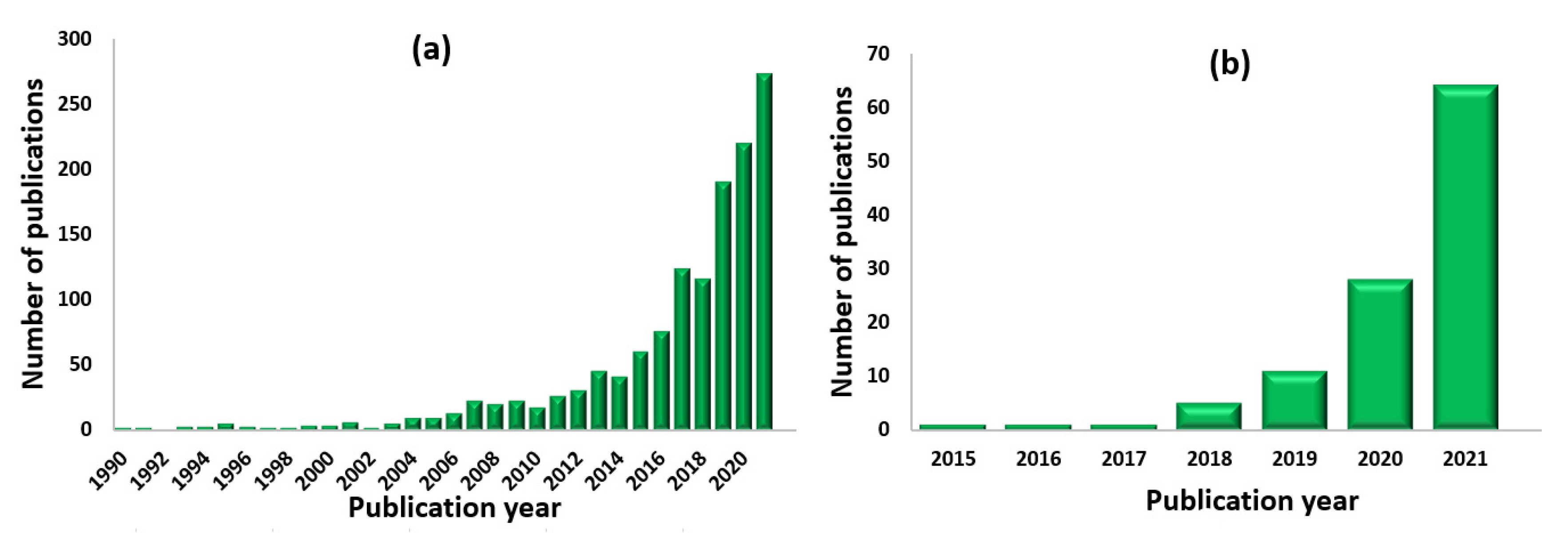


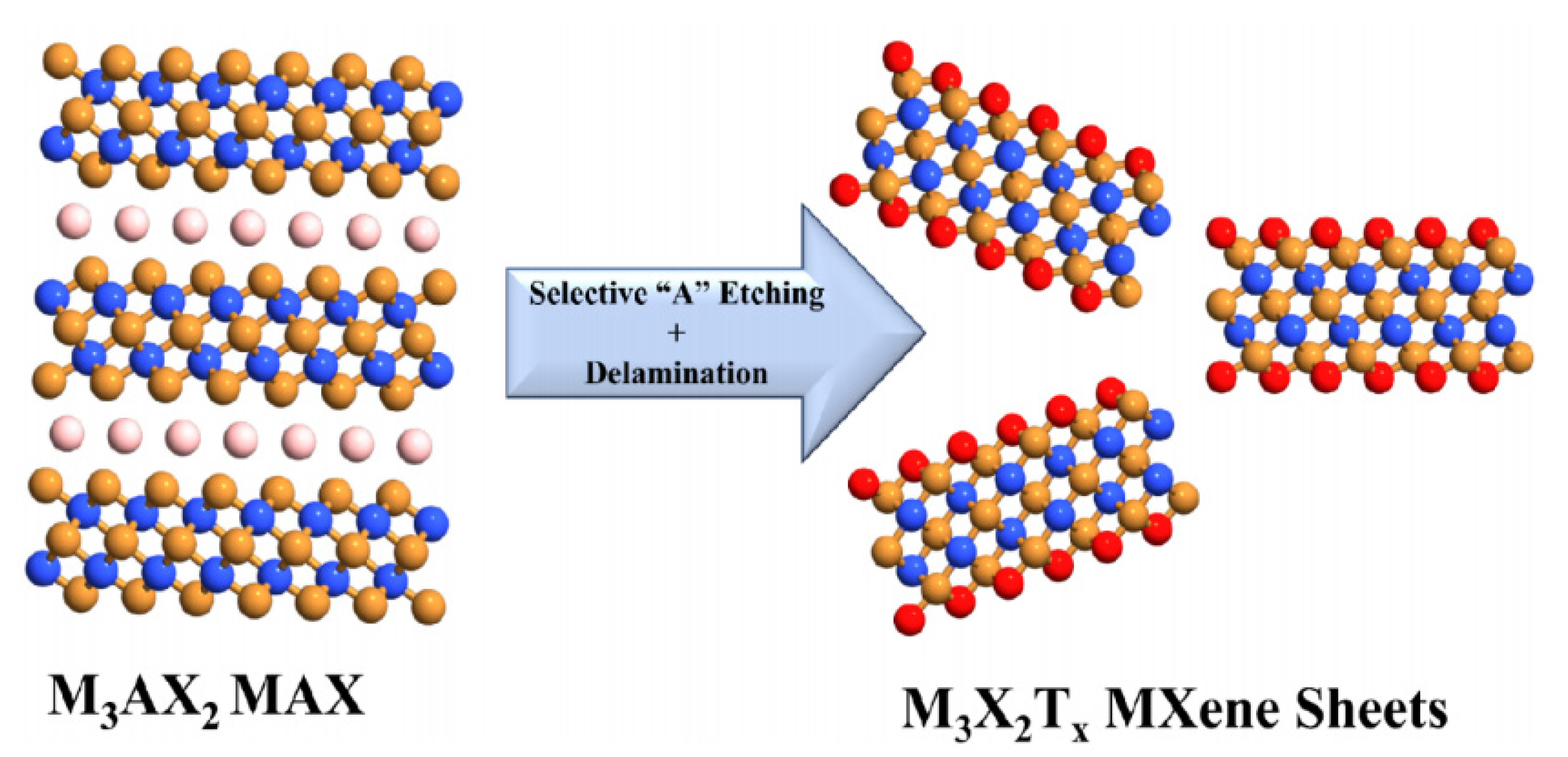
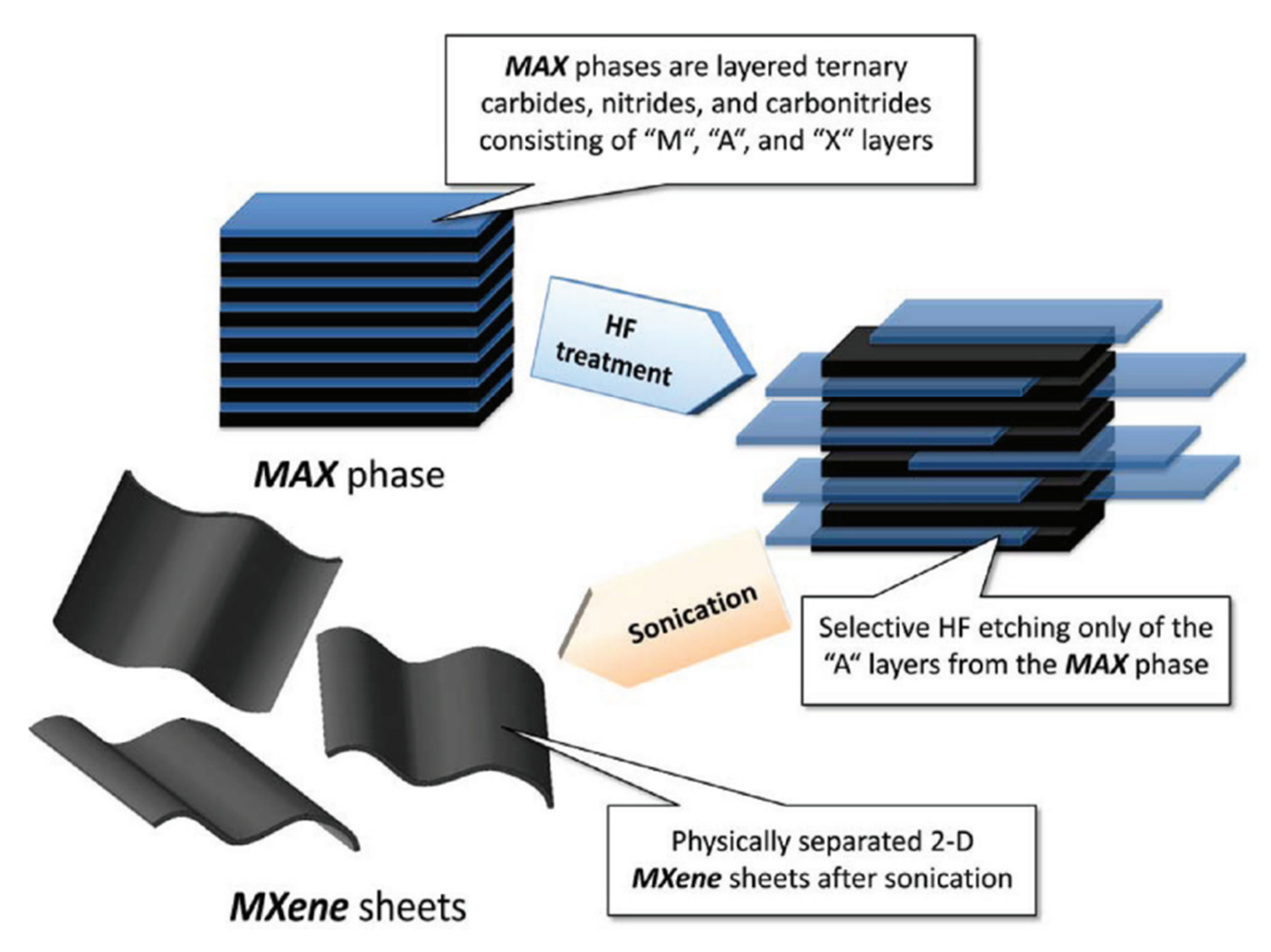








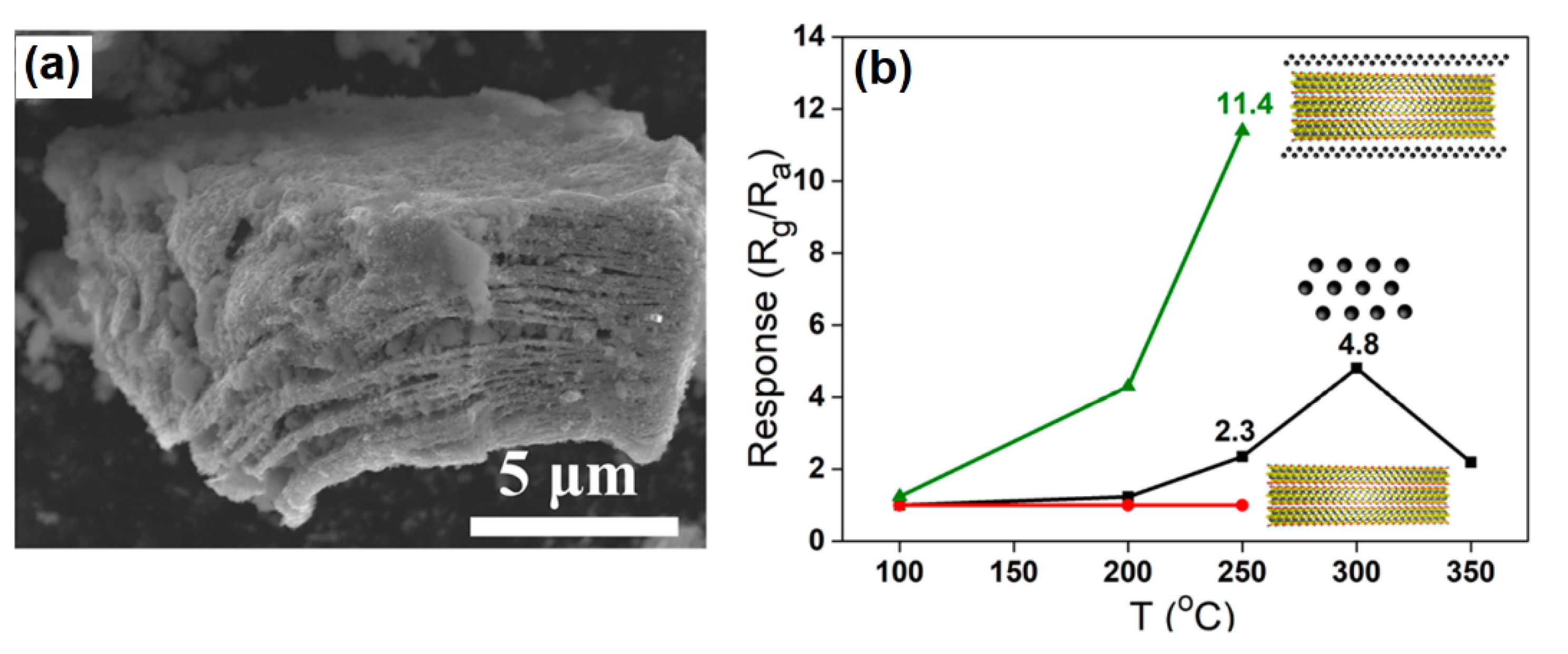

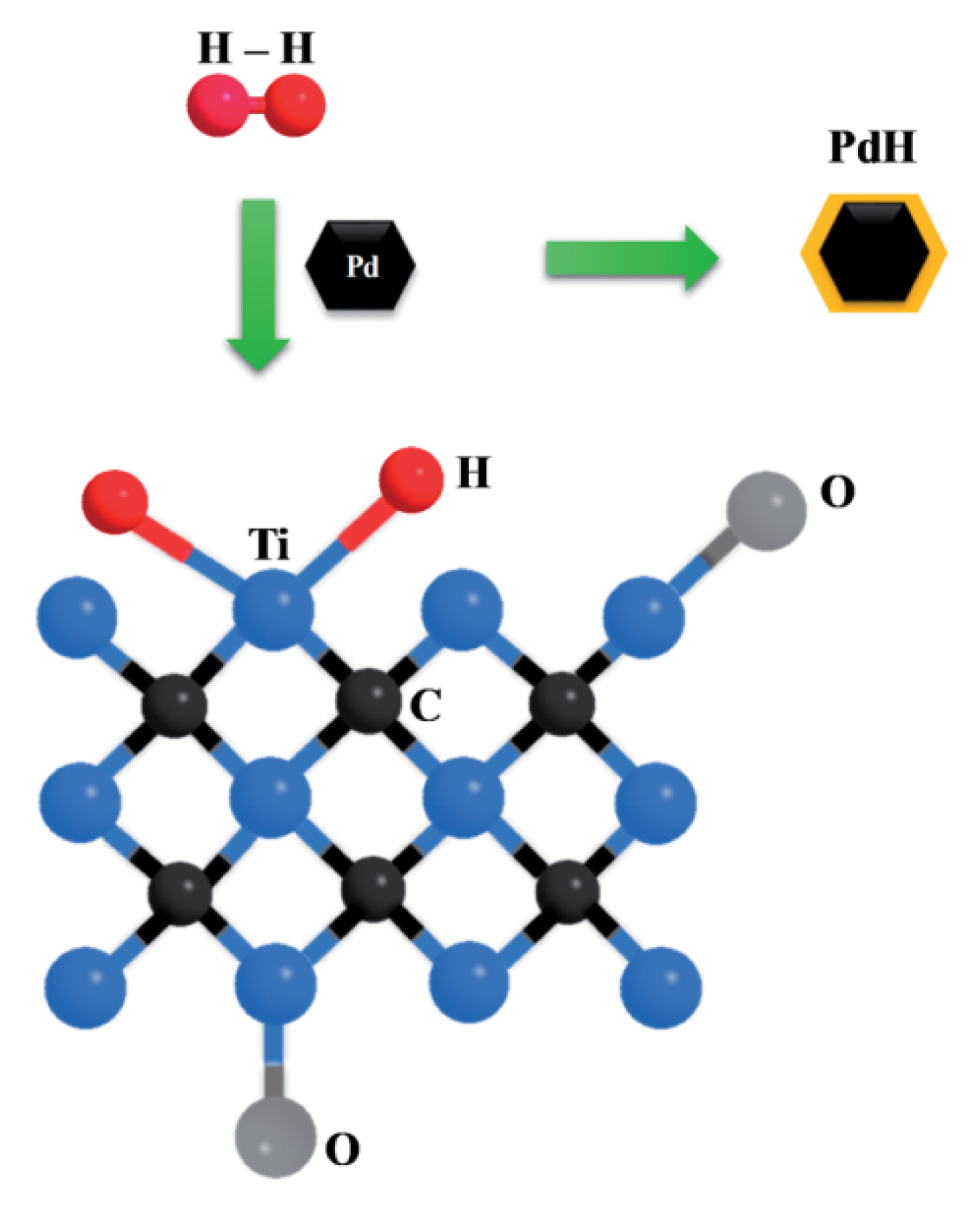
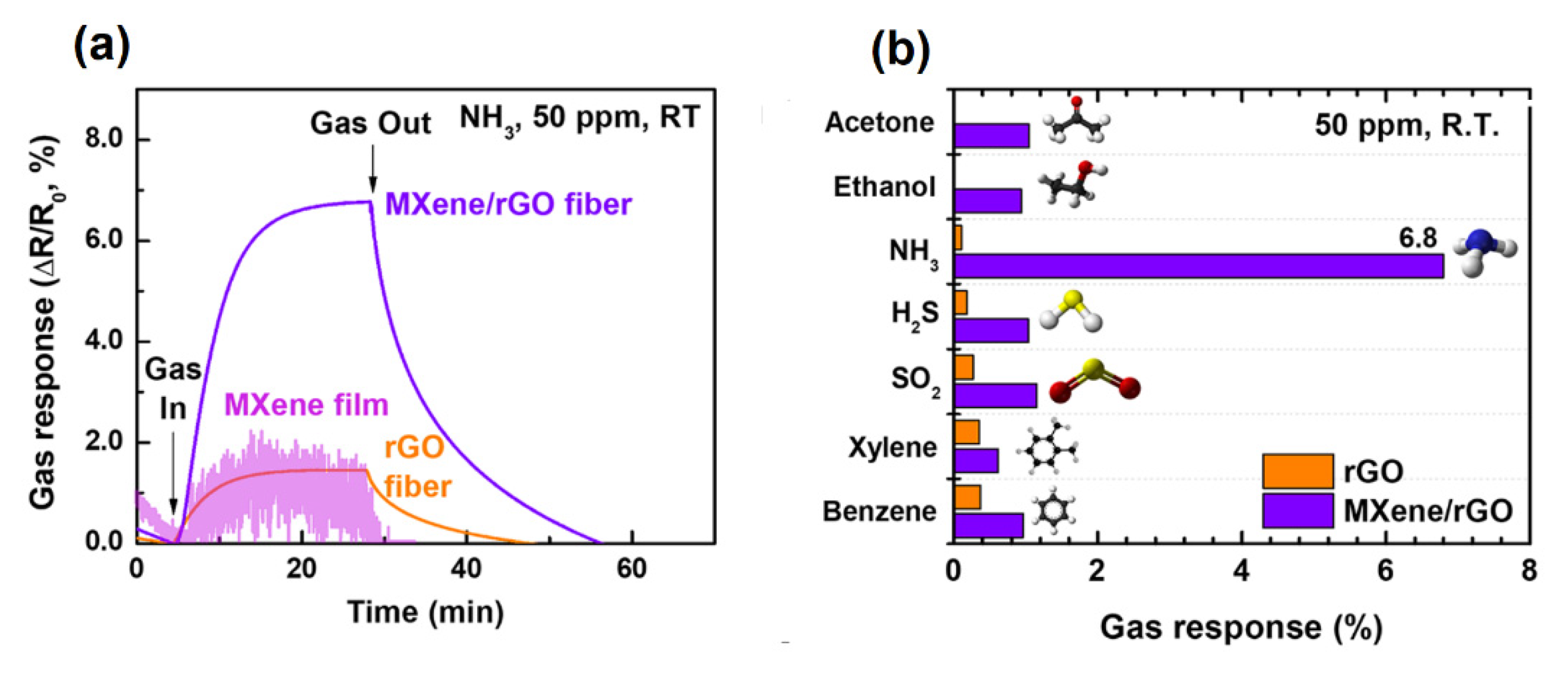





| MXene | Preparation Method | Test Gas | Concentration (ppm) | Detection Limit | Sensitivity (Rg−Ra)/Ra | Response/Recovery Time | Ref. |
|---|---|---|---|---|---|---|---|
| Ti3C2Tx | LiF/HCl-etching | Ethanol | 100 | 100 ppb | 1.7 | -/- | [6] |
| Acetone | 50 ppb | 0.97 | -/- | ||||
| Ammonia | 100 ppb | 0.8 | -/- | ||||
| Ti3C2Tx | LiF/HCl-etching | Methanol | 100 | - | 0.143 | -/- | [7] |
| Ethanol | - | 0.115 | -/- | ||||
| Acetone | 25 ppm | 0.075 | -/- | ||||
| Ammonia | - | 0.21 | -/- | ||||
| V2CTx | HF-etching | Acetone | 100 | 11.16 ppm | 0.0226 | -/- | [49] |
| Methane | 9.39 ppm | 0.0167 | 8/5 min | ||||
| H2 | 1.375 ppm | 0.2435 | 2/7 min | ||||
| H2S | 3.504 ppm | 0.005 | -/- | ||||
| Ti3C2 | NaF/HCl-etching | Ammonia | 500 | 10 ppm | 6.13% | ~2 min/ ~4 min | [81] |
| Ti3C2Tx | HF-etching | NO2 | 100 | - | 8% | -/- | [82] |
| NH3 | 100 | - | 17% | -/- | |||
| HF-etching + Alkalization | NO2 | 100 | - | 11% | -/- | ||
| NH3 | 100 | 10 ppm | 29% | -/- | |||
| V4C3Tx | HF-etching | Acetone | 100 | 1 ppm | 2.5 | -/- | [83] |
| Ti3C2Tx | Electrospinning technique | Acetone | ppb level | 50 ppb | 1.4% | <2 min | [84] |
| Ethanol | 1.75% | ||||||
| Methanol | 2.2% | ||||||
| Mo2CTx | HF-etching | Toluene | 100 | - | 2.65% | -/- | [85] |
| MXene | Synthesis Method | Test Gas | Concentration (ppm) | Detection Limit (ppm) | Sensitivity, (Rg−Ra)/Ra | Response/Recovery Time | Ref. |
|---|---|---|---|---|---|---|---|
| Ti3C2Tx/CuO | electrostatic self-assembly | Toluene | 50 | - | 11.4% * | 270 s/10 s | [48] |
| Ti3C2Tx/WSe2 | Surface treating and exfoliation-based process | Ethanol | 40 | 1 | 12% | 9.7 s/6,6 s | [55] |
| Ti3C2Tx/rGO | wet spinning | NH3 | 100 | 10 | 7.2% | -/- | [87] |
| Ti3C2Tx/ZnO | spray pyrolysis | NO2 | 100 | - | 41.9% | 34 s/105 s | [88] |
| Ti3C2/TiO2 | hydrothermal | Humidity | 7–97% | - | 1614 pF/%RF | 2.0 s/0,5 s | [90] |
| Ti3C2Tx/Pd | polyol | H2 | 100 | - | 56% | -/- | [91] |
| Ti3C2Tx/Pd | all-colloidal solution-based vacuum-filtration process | H2 | 4000 | - | 23% | 37 s/161 s | [92] |
| Nb2CTx/PANI | NH3 | 100 | - | 301.31% | 105 s/143 s | [116] | |
| Ti3C2Tx/PANI | wet chemistry | Ethanol | 200 | - | 41.1% | 0.4 s/0.5 s | [117] |
| Ti3C2Tx/SnO-SnO2 | hydrothermal | Acetone | 100 | - | 12.1% * | 18 s/9 s | [119] |
| Ti3C2Tx/ Fe2(MoO4)3 | hydrothermal | VOCs | 5−1000 | 5 | 43.1% | 18/24 s | [120] |
| Ti3C2Tx/PANI | self-assembly | NH3 | 50 | - | 400% | -/- | [121] |
Publisher’s Note: MDPI stays neutral with regard to jurisdictional claims in published maps and institutional affiliations. |
© 2022 by the authors. Licensee MDPI, Basel, Switzerland. This article is an open access article distributed under the terms and conditions of the Creative Commons Attribution (CC BY) license (https://creativecommons.org/licenses/by/4.0/).
Share and Cite
Nahirniak, S.; Saruhan, B. MXene Heterostructures as Perspective Materials for Gas Sensing Applications. Sensors 2022, 22, 972. https://doi.org/10.3390/s22030972
Nahirniak S, Saruhan B. MXene Heterostructures as Perspective Materials for Gas Sensing Applications. Sensors. 2022; 22(3):972. https://doi.org/10.3390/s22030972
Chicago/Turabian StyleNahirniak, Svitlana, and Bilge Saruhan. 2022. "MXene Heterostructures as Perspective Materials for Gas Sensing Applications" Sensors 22, no. 3: 972. https://doi.org/10.3390/s22030972
APA StyleNahirniak, S., & Saruhan, B. (2022). MXene Heterostructures as Perspective Materials for Gas Sensing Applications. Sensors, 22(3), 972. https://doi.org/10.3390/s22030972







